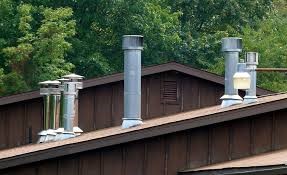Venting Gas Furnaces into Masonry Chimneys

By: Reggie Hucks | Feb 04, 2020
The combining of fuel, air and an ignition source creates combustion. This combustion process is utilized in furnaces and water heaters to heat air or water. Byproducts of combustion are carbon dioxide, water, occasionally carbon monoxide and other gases.
How does combustion in today’s appliance cause problems with masonry chimneys?
Thirty years ago, it was common practice to vent gas furnaces and water heaters into tile-lined masonry chimneys. These appliances used draft hoods, also known as draft diverters, in their venting systems. Appliances manufactured around this time were about sixty percent efficient (fuel used versus heat generated for the structure). The draft diverter introduced dilution air to the furnace vent gases, and with the escaping heat, prevented moisture issues in the chimney. Exterior chimneys and interior chimneys were commonly used for venting. Today’s mid-efficiency furnaces can destroy tile lined chimneys. Here are some technological differences with modern appliances that make using chimneys more difficult.
A furnace, currently manufactured, has an Annual Fuel Utilization Efficiency (AFUE) of either 80% or 90%+. There are no 85% efficient furnaces. Furnace with an efficiency of 80% run at the borderline of creating condensation in the combustion and venting operation. The flue gases are cooler and moisture laden. The furnaces don’t have a draft diverter; therefore, no extra dilution air is used in the venting process. Instead of a draft diverter, the furnaces have a small fan that induces draft and prevents downdrafts in the venting system.
A cold chimney liner will reach dewpoint quickly once the combustion process starts. Over time condensation and acidic components of flue gases eat into the clay tile liner of the chimney. This action will continue eroding the masonry and eventually destroy the integrity of the chimney. Additionally, the condensation will work its way to the furnace. The heat exchanger could rust out and introduce carbon monoxide into the structure.
Chimneys located on the exterior of a house will be colder than interior chimneys. A review of the International Fuel Gas Code will clearly show that exterior chimneys are off limits for single appliances. Two or more appliances could vent into an exterior chimney, but design conditions must be appropriate along with appliance fuel input. Additionally, one of the appliances must have a draft diverter (natural draft system).
Interior chimneys typically benefit from the heat of the structure. Because these chimneys aren’t as cold as the exterior kind, the application is a little different, but not that much. Some single appliances can vent into interior chimneys. The height of the chimney, the area of the liner, and the input of the appliance all play a role in the use of the chimney. However, using an interior chimney is extremely limited. For instance, a 100,000 BTU furnace venting into an interior chimney with a 38 square inch liner would not be allowed, regardless of chimney height. A review of the International Fuel Gas Code venting tables should be checked before venting into any chimney.
Furnaces with an AFUE of 90% and greater use special venting material such as PVC or stainless steel. A 90% furnace should never dump flue gases into a chimney. The installation instructions of these furnaces must be followed precisely for safe installation and operation. These furnaces produce large quantities of condensate as part of their operation. The condensate is drained from the furnace via piping and disposed in a safe place outside of the structure.
A contractor’s best course of action is to avoid a chimney altogether. Using an abandoned chimney as a chase for a metal venting system, such as “B” Vent, can be done. There are stainless steel chimney liner systems than can be installed too. But the tile lined chimney is quickly becoming something to avoid altogether with gas appliances.


I have a 7” type B chimney, I use it to run my PVC intake and exhaust through the roof. In a cold snap I had a ice blockage at the very end of my exhaust pvc vent. I want to replace the last 2.5’ with stainless steel so I can use heat tape if I need to warm up the last 2’ if needed. What glue would you suggest to bond the pvc and stainless steel. I will build a insulated chimney and leave the last six inches exposed to the climate.
Is it safe to eliminate this vent. It runs down through the roof into a closet which use to have a return for heat and air. Now I have all in one outside unit. And that vent blows hot air through it in my laundry room